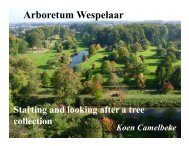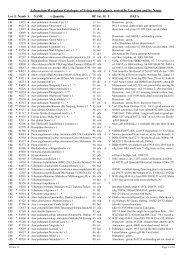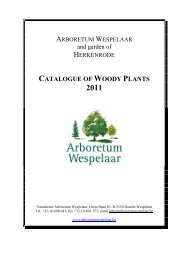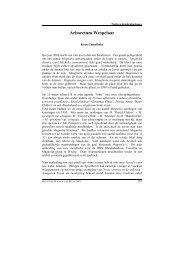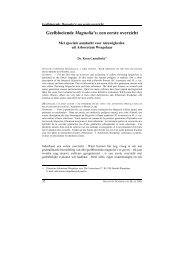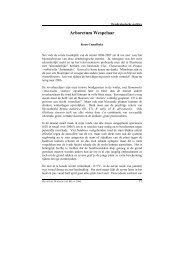Philippe de Spoelberch Arboretum Wespelaar 13 April 2013
Magnolia - Arboretum Wespelaar
Magnolia - Arboretum Wespelaar
Create successful ePaper yourself
Turn your PDF publications into a flip-book with our unique Google optimized e-Paper software.
<strong>Philippe</strong> <strong>de</strong> <strong>Spoelberch</strong><br />
<strong>Arboretum</strong> <strong>Wespelaar</strong><br />
<strong>13</strong> <strong>April</strong> 20<strong>13</strong>.
First of all: there may be better things to do<br />
than collecting magnolias<br />
• Other genera offer a much larger range of interests;<br />
• the magnolia season is fundamentally short<br />
• Flowers are often hit by spring frost; only one out of<br />
three years is blessed by a show of clean flowers<br />
• These shrubs are rather uninteresting during the rest of<br />
the year<br />
• Autumn coulours are rare.<br />
• Fruiting bodies may remain on shrubs long after<br />
shedding their seed and are not attractive.
You may nevertheless succumb to the temptation as<br />
we have at <strong>Arboretum</strong> <strong>Wespelaar</strong> :<br />
Hereun<strong>de</strong>r, the collection of species and hybrids of the Buergeria group<br />
(now in sub subsection Yulania)<br />
In<strong>de</strong>ed, even if it only shines for a couple of weeks, a complete collection<br />
is always a fascinating achievement for the <strong>de</strong>dicated magnoliaphile<br />
But if not well presented and justified, it will most probably be rather<br />
boring for the uneducated or less passionate visitor to the collection
• Most of all it must be beautiful: aesthetic<br />
consi<strong>de</strong>rations must dominate over quantity.<br />
• Secondly, the collection must follow a main<br />
theme and a clear logic.<br />
• Thirdly, it should offer something original and<br />
distinctive, set apart from other similar<br />
collections and possibly even offering<br />
something different from other national or<br />
international magnolia collections
• This is a matter of personal taste; but one must<br />
make a choice; and then be consistent<br />
• Unfortunately the collector will often neglect these<br />
principles and keep adding plants, leading to an<br />
untidy chaos. Do have the courage to move young<br />
plants and cut old ones, if they are not in the right<br />
spot or have become ungainly<br />
• The most popular style for botanical collections is<br />
that of the informal landscape gar<strong>de</strong>n. But a<br />
regular gar<strong>de</strong>n in the right environment could do.
Trial grounds and nurseries are best disposed on a regular basis but<br />
this is not a gar<strong>de</strong>n and these trial beds will go as soon as the crosses<br />
will have been evaluated.
Irregular beds are probably easier to manage and blend well with a<br />
typical landscape concept
I have mixed feelings when it comes to planting magnolias on a lawn: they<br />
soon look lost, as they dot the area. One way to group them may be on<br />
undulating mounds
Another alternative may be to manage the grounds differently with taller<br />
grass around the plants and neatly mowed paths and open areas between<br />
these (possibly cut twice or three times during the season). Hopefully,<br />
even the more blasé of gar<strong>de</strong>n visitor will find an interest in such a layout
And don’t forget to associate the magnolias with other trees and shrubs<br />
In the center :Fagus sylvatica ‘Dawyck’ a clear architectural contribution.<br />
Conifers are useful backgrounds at flowering time. (Abies x borisii-regis)
There are probably dozens of possible concepts<br />
to organize a collection.<br />
Here are a few which might provi<strong>de</strong> interest and<br />
value:<br />
1. Species and grouped in a systematic layout<br />
2. Hybrids grouped by parentage<br />
3. Geographical origins<br />
4. Historical cultivars and introductions<br />
5. Colour schemes<br />
6. Climate zones and hardiness<br />
7. Threatened species (IUCN criteria)<br />
8. Merit : « Top ten » for various uses<br />
9. Flowering time
I have followed the Magnolia Society<br />
International and IUCN (BGCI) Red List<br />
treatment for the presentation of this theme.<br />
The hardy species can be grouped in<br />
3 subgenera<br />
12 sections<br />
21 subsections<br />
Those species consi<strong>de</strong>red hardy in Western Europe are<br />
hereafter indicated in yellow
Subgenus Magnolia<br />
Section Magnolia: M. grandiflora, virginiana, schie<strong>de</strong>ana, tamaulipana<br />
Section Gwillimia:<br />
Subsection Gwillimia M. <strong>de</strong>lavayi (henryi)<br />
Subsection Blumania (all subtropical)<br />
Section Talauma (55 species, none hardy)<br />
Subsection Talauma (31 species: Central America)<br />
Subsection Dugandio<strong>de</strong>ndron (14 species: Colombia and Venezuela)<br />
Subsection Cubense (10 species: Cuba, Haïti, Rep. Dominican, Porto Rico)<br />
Section Manglietia (35 sp.): M. conifera, <strong>de</strong>cidua, insignis, fordiana, yuyuanensis<br />
Section Kmeria (3 species from South East Asia, none are hardy)<br />
Section Rhytidospermum<br />
Subsection Rhytidospermum: M. tripetala, obovata, officinalis, rostrata<br />
Subsection Oyama: M. sieboldii, - var. sinensis, wilsonii, globosa<br />
Section Auriculata: M. fraseri, - var. pyramidata<br />
Section Macrophylla: M. macrophylla, - var. ashei, - var. <strong>de</strong>albata
Subgenus Yulania<br />
Section Yulania<br />
Subsection Yulania (China, Japan and Korea)<br />
1 - campbellii, sprengeri, - var. elongata, dawsoniana, sargentiana<br />
2 - <strong>de</strong>nudata, liliiflora, cylindrica,<br />
3 - kobus, stellata, salicifolia<br />
4 - amoena, biondii, zenii<br />
Subsection Tulipastrum: acuminata , - var. subcordata<br />
Section Michelia<br />
Subsection Michelia: cavaleriei, var. platypetala, laevifolia, doltsopa, ernestii, foveolata,<br />
maudiae,<br />
Subsection Elmerrilia (6 sp., Philippines, Indonesia)<br />
Subsection Maingola (11 sp. India, Vietnam, Borneo etc)<br />
Subsection Aroma<strong>de</strong>ndron ( 5 species, Sumatra Borneo)<br />
Subgenus Gymnopodium<br />
Section Gymnopodium: M. nitida, lotungensis<br />
Section Manglietiastrum: (One species, Yunnan)
Magnolia grandiflora<br />
Needs no introduction<br />
Hardy versatile, happy both in<br />
Mediterranean climate (Huntingdon)<br />
and maritime climate, possibly on a<br />
wall here at Lanhydrock , in the UK.
Magnolia virginiana, vigorous, healthy, adaptable,<br />
From the east coast of North America all the way from Cuba to Massachusetts.<br />
var. australis here at Bellengrath Gar<strong>de</strong>n , Mobile, Alabama).
M. virginiana, along water ways , even brackish as here again in Bellengrath<br />
Gar<strong>de</strong>n, (Alabama) with Liquidambar styraciflua. (Note enlarged stump on both)
Only one hardy species in Western Europe: Magnolia <strong>de</strong>lavayi,<br />
Here in Kunming , Sichuan (at Fragrant Hills)<br />
And in the UK (High Beeches), on a carpet of bluebells (Hyacinthoi<strong>de</strong>s nonscripta)
And in Ireland, on the occasion of a previous MSI visit (Birr Castle)
First night : Flowers opening and receptive to pollen until the<br />
morning, (necessary hand pollination as there seems to be no<br />
pollinating insect for this magnolia in Belgium)
Morning of the second night: pollen collected for fertilizing the next opening flower.
Mainly Asiatic plants, from the Himalaya to China, Vietnam, Laos,<br />
Borneo. Previously in the genus Manglietia, these subtropical plants are<br />
now merged into Magnolia.<br />
Several species are hardy in zone 7 and 8 :<br />
Magnolia conifera, <strong>de</strong>cidua, insignis, fordiana, yuyuanensis.<br />
There is a lot to play with in this section and M. insignis seems particularly<br />
promising for the hybridizer.<br />
I would love to see a specialized collection on the Atlantic coast of the UK,<br />
France or Northern Spain to hold and evaluate all these new species and<br />
their hybrids.
We have one hardy plant in the section at <strong>Arboretum</strong> <strong>Wespelaar</strong>: M. <strong>de</strong>cidua, the<br />
only <strong>de</strong>ciduous member of the section. It has recently flowered at Kunming<br />
Botanical Gar<strong>de</strong>n. It will be interesting to cross it with other members of the<br />
section in particular M. insignis.
Magnolia <strong>de</strong>cidua first flowering in cultivation, at<br />
Kunming BG<br />
(Photo Sun Wei-Bang)
Magnolia insignis, Zibenshan National Park, Yunnan, coppiced over and over<br />
again, but growing strongly
Magnolia insignis (Zibenshan)<br />
Magnolia insignis (Caerhays gar<strong>de</strong>n)
Magnolia insignis<br />
(Photo Dick Figlar)
Close to the previous subsection (Manglietia) and easily<br />
hybridized with the following (Oyama)<br />
Once again many possibilities for good crosses.<br />
Four species, found on two continents !<br />
M. tripetala on the East coast of North America<br />
M. obovata in Asia (China, Korea, Japan)<br />
M. officinalis and officinalis var. biloba in China<br />
M. rostrata in China
M. tripetala
M. tripetala
Magnolia obovata (syn. hypoleuca)
M. obovata (syn. hypoleuca)
Magnolia officinalis and officinalis var. biloba<br />
This is a curious association: there is more difference<br />
between var. biloba and officinalis than between officinalis<br />
and obovata<br />
M. officinalis seems intermediate between obovata and var.<br />
biloba and could be a hybrid as mentioned by Dr. Stephen<br />
Spongberg. And var. biloba would then be the species.<br />
It is most difficult to i<strong>de</strong>ntify the original geographic<br />
distribution as all these magnolias have been largely<br />
cultivated the bark being used in traditional Chinese<br />
medicine.
Three close taxa and a hybrid compared<br />
officinalis
Wind in the leaves of Magnolia officinalis (Damao shan)
Magnolia officinalis (Damaoshan, China)
Magnolia officinalis var. biloba
Magnolia rostrata is of limited hardiness. It survives in Southern UK (Nymans)<br />
and thrives on the West coast of Scotland.(Glenarn)
Three or Four species, all Asiatic, and closely related:<br />
•M. sieboldii (Japan, Korea and Northern China)<br />
•M. wilsonii (and M. sinensis ) in China<br />
•M. globosa in the Himalaya<br />
They are charming short lived shrubs, easily crossed with<br />
species of the Rhytidospermum subsection, and probably<br />
Manglietia subsection.<br />
NB: Magnolia sinensis, is in fact very different from Magnolia sieboldii.<br />
It has been treated as a variety of sieboldii , but it is much closer to<br />
wilsonii. Flowers and fruit of sinensis are i<strong>de</strong>ntical to those of wilsonii;<br />
only the leaf and colour of the shoot are in anyway different.
Magnolia wilsonii (horizontal flowers)<br />
Magnolia sieboldii (vertical flowers)
On M. wilsonii the one year shoot is dark brown,<br />
On M. sinensis the shoot is pale beige
There are numerous inter-specific hybrids between members of both Oyama and<br />
Rhytidospermum subsections.<br />
There are many opportunities for crosses and selections.<br />
And they <strong>de</strong>serve a specialized collection of their own.<br />
At least M x wieseneri (obovata x sieboldii) and<br />
‘Nimbus’ (obovata x virginiana), should be in<br />
every collection. They are among the most<br />
scented of magnolias.
Magnolia fraseri and fraseri var.<br />
pyramidata are both en<strong>de</strong>mic to the<br />
eastern United States. Both will<br />
become large trees. They have<br />
superficial characteristics in common<br />
with M. macrophylla (large leaves<br />
with auricled base), but are really in<br />
very different sections.
Magnolia fraseri (S. Appalachians, South Carolina ) –<br />
(<strong>Arboretum</strong> <strong>Wespelaar</strong> 03250-wld-203)
Magnolia macrophylla
Magnolia macrophylla, a large tree,<br />
• as an isolated specimen (Henry Foundation, Gladwyn, Pa)<br />
• or as a forest tree (Barnes <strong>Arboretum</strong>, Phila<strong>de</strong>lphia, Pa)
The subsection Yulania contains most of the great early flowering<br />
<strong>de</strong>ciduous magnolias which are well known and loved by the<br />
horticultural world.<br />
All originate in Asia<br />
They can be listed in four basic groups:<br />
1. campbellii, dawsoniana, sargentiana, sprengeri, sprengeri var. elongata<br />
2. <strong>de</strong>nudata, liliiflora (and their hybrid x soulangeana), cylindrica<br />
3. kobus, stellata, salicifolia (the old Buergeria group)<br />
4. amoena, biondii, zenii (precocious flowering trees)
1 - campbellii, sprengeri, sprengeri var. elongata, dawsoniana, sargentiana<br />
These are the 5 giant flowered magnolias of the Himalaya and South Western China<br />
Unfortunately the plants in this group are not very hardy In Europe they are mostly<br />
grown in the South and West of the British Isles. They should do well on the Atlantic<br />
coast of Spain and Portugal.<br />
Magnolia campbellii , is one of the giants of the Himalayas;<br />
A tree in Bhutan (Gante Gompa) has been measured at 4.50 m girth x 25 m height.<br />
There are many variations from west to east: from var. alba, to var. mollicomata
Magnolia campbellii var. alba, 3 000 – 3 200 meters, Bhutan
Magnolia campbellii var. alba , with Rhodo<strong>de</strong>ndron arboreum (on the Dochu La, 3200 m, Bhutan)
Magnolia campbellii<br />
Raffillii Group
Magnolia sprengeri was introduced into cultivation by Wilson un<strong>de</strong>r Wilson 688.<br />
Out of that seed lot came 7 white flowering plants (var. elongata) and one<br />
extraordinary pink flowered tree which has been given the cultivar name ‘Diva’.<br />
Magnolia sprengeri var. sprengeri<br />
As seen from the next sli<strong>de</strong>, there seems to be in the wild, a complete<br />
continuum of forms and colours, so that it will be near impossible to set a<br />
<strong>de</strong>fining criteria between both taxa (Erland Ej<strong>de</strong>r to RHS Woody Plant<br />
Committee 10 <strong>April</strong> 2012)
All photographs courtesy of Erland Ej<strong>de</strong>r , RHS, <strong>April</strong> 2012
Magnolia sprengeri var. elongata
Magnolia sprengeri var. elongata –<br />
Ex Foping Nature reserve, at Morris <strong>Arboretum</strong><br />
Photograph by A. Aiello
Magnolia dawsoniana<br />
Magnolia sargentiana<br />
Magnolia dawsoniana<br />
Magnolia sargentiana var. robusta
2 - Magnolia <strong>de</strong>nudata, liliiflora (x soulangeana), cylindrica<br />
M. <strong>de</strong>nudata M. liliiflora<br />
M. x soulangeana M. cylindrica
3 – The Buergeria group<br />
M. kobus, stellata, salicifolia and hybrids<br />
kobus<br />
x loebneri<br />
x kewensis<br />
stellata<br />
x proctoriana<br />
salicifolia
Magnolia kobus<br />
Magnolia stellata<br />
Magnolia salicifolia<br />
Magnolia salicifolia
4 - Magnolia amoena,<br />
biondii and zenii<br />
I have placed, for my own<br />
convenience, these three species in<br />
the fourth group. They are all very<br />
precocious flowering trees.<br />
Magnolia biondii , is probably the<br />
best known, won<strong>de</strong>rfully scented.<br />
M. amoena<br />
M. biondii<br />
M. zenii
One species Magnolia acuminata and one variety, var. subcordata,<br />
the only species contributing the yellow colour to hardy <strong>de</strong>ciduous hybrid<br />
magnolia
Magnolia acuminata var. subcordata
Subsection Michelia :<br />
Magnolia cavaleriei, -var. platypetala, laevifolia, doltsopa, ernestii, faveolata,<br />
maudiae<br />
All species in section Michelia are evergreen. Few are hardy.<br />
• Michelia laevifolia is perfectly hardy and must be planted in full<br />
sun,<br />
• Magnolia maudiae and doltsopa are well established in Cornwall.<br />
• Magnolia cavaleriei var. platypetala is hardy in Western Canada, in<br />
zone 6!
Magnolia laevifolia
Not too floriferous in woodland conditions
Magnolia cavaleriei var. platypetala - Pickens S.C., USA - (Photo Dick Figlar)
Magnolia doltsopa – Caerhays Castle, Cornwall GB - 2008.0323
Magnolia 'Jack Fogg' (doltsopa x figo)
Magnolia nitida, not hardy<br />
Whereas M. lotungensis is<br />
hardy in zone 6.<br />
Magnolia nitida - UK, Cornwall, Caerhaeys C.
The soulangeana hybrids (<strong>de</strong>nudata x liliiflora)<br />
The Gresham hybrids (veitchii x)<br />
The Buergeria hybrids ( loebneri, kewensis, proctoriana)<br />
Hybrids of sprengeri, campbellii, sargentiana and dawsoniana.
Yellows born from crosses with M. acuminata are now numerous and need to be<br />
evaluated, improved and possibly conserved
Deep reds and purples will be in <strong>de</strong>mand. Again evaluation,<br />
improvements and conservation will be nee<strong>de</strong>d.<br />
Magnolia liliiflora<br />
Magnolia campbellii var. mollicomata<br />
Magnolia ‘Black tulip’<br />
Magnolia ‘Vulcan’
Magnolia ‘Vulcan’ (liliiflora x mollicomata ‘Lanarth’)
Pure whites, late flowering and with 12 large tepals based on Magnolia campbellii<br />
var. alba, <strong>de</strong>nudata, cylindrica, stellata should produce great collections<br />
Magnolia stellata<br />
Magnolia campbellii var. alba<br />
M. ‘Leda’ (campbellii var. alba x ‘Pegasus’) Magnolia ‘David Clulow’
Magnolia 'Sybille' ('White Giant' x 'Leda')
Magnolia 'Joli Pompon' ('David Clulow' x sprengeri var. elongata)




